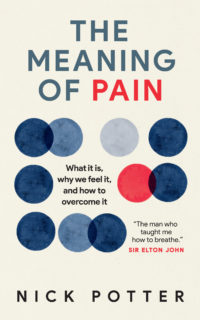Book review: The Meaning of Pain

In the highly readable book ‘The Meaning of Pain’, Nick Potter reaches out to the subset of chronic pain sufferers for whom other treatments have failed to help.
By illustrating the connections between the body’s physiological pain mechanisms, changes in the central nervous system, endocrine and immune function, Potter shows how the two-way process between mind and body – particularly after having experienced previous mental or physical trauma – can lead to engrained and triggered pain patterns, sustaining pain which ostensibly should have healed long ago.
Illustrating how traumas can lay enduring patterns of pain and pain responses, he describes the development of neurosignatures, which can be linked to, and triggered by, associated memories. With repeated reinforcement, the body’s continued response to a non-existent threat gives rise to a state of ‘physiological hypervigilance’, which links stress with pain.
Research cited here suggests, credibly, that the paradigm that we all cite for patients with back pain – that ‘90% get better anyway’ – is quite probably wrong; perhaps the more realistic figure is only 25%. This means that the problem of chronic pain in society is probably far larger than even our contact from patients might suggest.
As a GP, I see many such patients with musculoskeletal pain, who have been through the medical mill and out the other side, but with little changing as a result.
Potter draws a timely allusion to the dangers in treating these patients with increasingly powerful pain relief
Burgeoning opiate prescriptions for chronic pain are a significant problem, and Potter draws a timely allusion to the dangers and limitations in effectiveness of treating these patients with increasingly powerful pain relief.
In the USA, there are currently unprecedented numbers of overdoses due to prescribed opioid analgesics, while several of the pharmaceutical companies that produce them have been convicted of illegal marketing and bribing doctors as part of measures to spread the use of opiates.
In contrast to Potter’s life’s work as a successful osteopath, he barely mentions osteopathy in this book. This is more for those for whom manual therapy, such as physiotherapy, yoga and analgesics haven’t worked. Potter engages a salutary whole-person approach to getting to know more complex biopsychosocial causes of one’s persisting pain, and he provides people with some useful means of taking control themselves to relieve suffering from pain – or even, perhaps, pre-empting it – by addressing those causes. Recognising elements of central sensitisation is key to finding ways to address it.
Pain is so much more than just a sensation. Reading this book may help sufferers to recognise and explore connections between their pain and stress, give it meaning from their own lives and perspective, and inspire them to take steps to regain conscious control in turning their lives around. It may also help the people whom Potter describes as ‘corporate athletes’: a notion derived from his work on performance in elite sportspeople, and extrapolated to people operating in ‘high-stress executive environments’.
I would recommend this book, but not to doctors alone. In fact, I would particularly do so as a resource for patients referred to pain clinics to read as part of a multidisciplinary approach to recovery and rehabilitation.
Whilst ‘The Meaning of Pain’ contains a holistic/medical nuance, it isn’t a medical text and shouldn’t be taken as such.
I bear this in mind while also feeling obliged to point out that excessive cortisol doesn’t cause inflammation, and that perhaps the link to stress causing the onset of multiple sclerosis and rheumatoid arthritis is overstated.
Dr Nick Mann is a GP and osteopath in Hackney, East London
‘The Meaning of Pain’ is published by Short Books Ltd
Pulse July survey
Take our July 2025 survey to potentially win £1.000 worth of tokens













